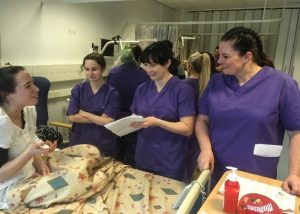For the sake of viewer convenience, the content is shown below in the alternative language. You may click the link to switch the active language.
Recently, ELTA award winner, Jonathan Hinkin, from Swansea University’s College of Human and Health Science, delivered the second seminar in SALT’s ‘7 Characteristics’ series, ‘Scenario-Based Learning: Closing the Gap’.

What are the 7 Characteristics
of Good Higher Education?
- Encourage contact between students and faculty
- Develop reciprocity and cooperation among students
- Encourage active learning
- Give prompt feedback
- Emphasise time on task
- Communicate high expectations
- Respect diverse talents and ways of learning
(Chickering and Gamson 1987)
More information on the theme and links to past events can be found by clicking on this link:
7 Characteristics of a Good University Teacher
What was the Theme of the Seminar?
Jon demonstrated how scenario-based teaching, learning and feedback with second-year Nursing students meet several of the principles identified in Chickering and Gamson’s 1987 extensive research. In doing so, the gap between theory and practice is reduced, providing a safe yet authentic environment. These methods have been proven to help the development of professional skills, with consistent, overwhelmingly positive student feedback.
Before his seminar, Jon invited me along to one of his ‘Infection Control’ scenarios – I felt very privileged! A number of Jon’s expert colleagues had occupied carefully thought through roles as patients in hospital beds. Students were required to use their clinical knowledge and interpersonal skills to spot hazards and risks in relation to infection control for each case, on a rotation system. Jon’s colleagues skilfully and smoothly alternated ‘in and out’ of their roles, asking probing questions and offering lots of encouragement and praise to students who remained highly engaged throughout the session. They then reflected on their own learning using a ‘diamond model’.
Find out about Jon planning and management of the scenarios, as well as how he thinks they meet the ‘7Cs’, in the video of his full presentation here.
Here’s just a selection of the type of comments Jon has received from his scenario-based sessions:-
Really enjoyed today. I learn better by doing and it was far more
interesting and informative than sitting in a lecture. Gave me a lot to think about
The role play captured your attention and being
involved helps to consolidate previous learning
A different but enjoyable experience,
good to put things into practice in the safety of the university
Closing the Gap
I found the evidence Jon presented on how best to apply theory to practice (closing a potential ‘gap’) particularly interesting. The evidence base included a study completed by Jon himself along with Jayne Cutter in 2014.
Learning opportunities that prepare students for their future professional roles certainly seem to be high on the HE agenda at the moment. I think it’s great that we have good examples like Jon’s happening here at Swansea.
We hope this example will be helpful to Academics in all disciplines who want to introduce scenario-based methods for the first time, to meet many of the ‘7Cs’ in the process.
Please let us know how your own approach goes if you feel inspired.
Hope to see you at the next 7Cs event!
Rhian
Please also contact Rhian Ellis (details below) if you would like any further information on attending or participating in the sessions.
r.e.ellis@swansea.ac.uk tel 01792 604302 http://salt.swan.ac.uk





